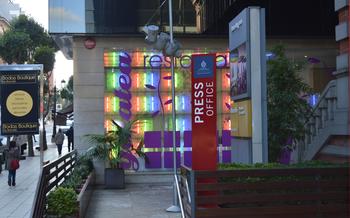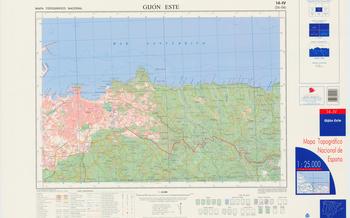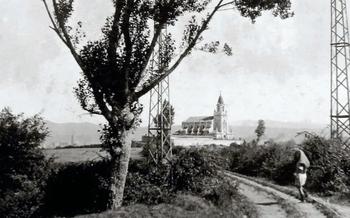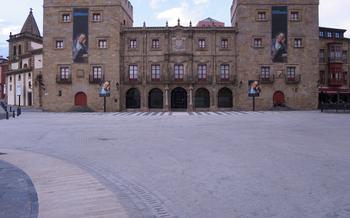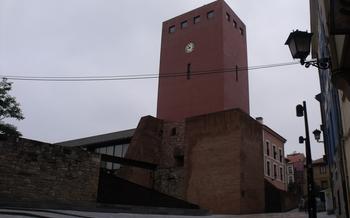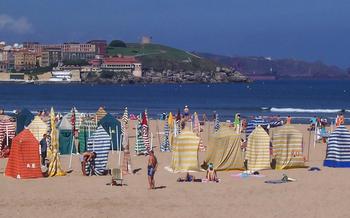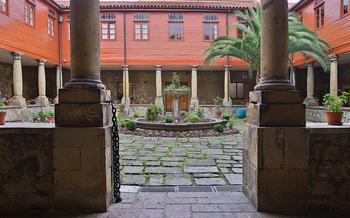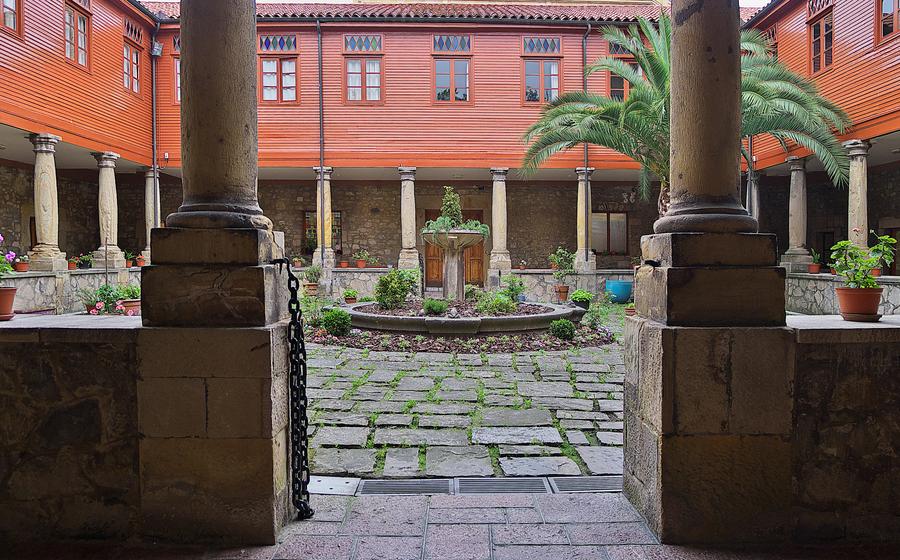
Bufones de Pría
- Gijón, a City of Wonders
- Discovering the Bufones de Pría
- Exploring the Bufones de Pría Nature Reserve
- Witnessing the Power of the Sea
- Capturing the Moment
- Exploring Nearby Attractions
- Indulging in Local Cuisine
- Accommodation Options
- Transportation and Accessibility
- Planning Your Visit
- Local Customs and Etiquette
- Budgeting for Your Trip
- Responsible Tourism
- Insider Tip: Exploring Hidden Gems and Local Delights
Gijón, a City of Wonders
Gijón, a vibrant city nestled on the Bay of Biscay, boasts a rich history, a dynamic culture, and a stunning natural setting. Once a humble fishing village, Gijón has transformed into a thriving metropolis, while retaining its maritime heritage. This modern and cosmopolitan city is committed to sustainability and eco-friendly initiatives, making it a prime destination for travelers seeking a blend of urban exploration and natural wonders. Roam the charming streets, embrace the vibrant atmosphere, and discover the hidden gems that make Gijón a truly remarkable destination.
Discovering the Bufones de Pría
The Bufones de Pría are a natural phenomenon located near Gijón, Spain, that showcases the power and beauty of the sea. These blowholes, formed by geological processes that have shaped the cliffs, caves, and underground channels, create a unique spectacle when waves compress air and expel it upwards through the blowholes. The result is a thrilling display of water jets shooting up from the ground, reaching heights of up to 30 meters. The best time to witness this awe-inspiring phenomenon is during high tides and stormy weather, when the waves are at their most powerful. The Bufones de Pría are a testament to the forces at play in the marine environment, offering visitors a glimpse into the raw power of nature.
Exploring the Bufones de Pría Nature Reserve
The Bufones de Pría Nature Reserve encompasses the blowholes and their surrounding landscape, creating a protected natural area of exceptional beauty. Within the reserve, visitors can immerse themselves in the diverse flora and fauna that thrive in this unique ecosystem. Seabirds, including gulls, cormorants, and razorbills, soar through the skies, while migratory birds, such as storks and herons, make temporary homes in the reserve during their seasonal journeys. The marine life is equally rich, with a variety of fish species, mollusks, and crustaceans inhabiting the waters around the blowholes.
To fully appreciate the reserve's natural wonders, visitors can embark on the well-marked walking trails that wind through the landscape. The paths offer stunning views of the blowholes and the coastline, allowing visitors to witness the spectacle of the water jets from various vantage points. Several viewpoints have been strategically placed to provide unobstructed views of the blowholes and the surrounding scenery.
It is crucial to remember that the Bufones de Pría Nature Reserve is a delicate ecosystem, and responsible tourism practices are essential for its preservation. Visitors should stay on designated trails to avoid disturbing the wildlife and refrain from littering to keep the environment clean. By respecting and protecting the reserve, visitors can ensure that future generations can also enjoy this natural treasure.
Witnessing the Power of the Sea
The Bufones de Pría offer a mesmerizing spectacle of nature's raw power. As the waves crash against the cliffs and enter the blowholes, they are compressed and forced upwards, creating powerful water jets that can reach heights of up to 30 meters. The thunderous sound of the waves and the sight of the water jets shooting into the air create an awe-inspiring experience. It is a testament to the immense force of the sea and the processes that have shaped this unique natural phenomenon. Standing near the blowholes, visitors can feel the power of the ocean and the energy released by the waves as they interact with the geological formations. It is a truly unforgettable experience that leaves visitors with a deep appreciation for the beauty and wonder of the natural world.
Capturing the Moment
The Bufones de Pría present a unique opportunity for photographers to capture the beauty and energy of nature's spectacle. The dramatic water jets, the rugged cliffs, and the crashing waves create a visually stunning composition that is sure to leave a lasting impression.
To capture the best shots, it's important to consider the camera settings, timing, and composition. Using a tripod is recommended to ensure stability and avoid camera shake, especially when capturing long exposures. Experiment with different shutter speeds to freeze the motion of the water jets or create a sense of movement and blur.
Timing is crucial when photographing the Bufones de Pría. The best time to visit is during high tides, particularly during stormy weather, when the waves are at their most powerful, and the water jets reach their maximum height.
Composition is key to creating a visually appealing image. Experiment with different angles and perspectives to find the most flattering viewpoint. Consider including elements of the surrounding landscape, such as the cliffs, caves, or vegetation, to create a sense of depth and context.
Remember to respect the natural environment and avoid disturbing the wildlife while taking photos. Stay on designated paths and viewpoints, and be mindful of your surroundings. Share your experiences and the wonders of the Bufones de Pría with others through social media and online platforms, but always tag responsibly and credit the location to raise awareness and promote sustainable tourism.
Exploring Nearby Attractions
The Bufones de Pría is situated in a region brimming with captivating attractions. A short drive away, you'll find the enchanting Playa de Gulpiyuri, a hidden gem nestled within a sinkhole. This unique beach offers a serene escape from the crowds, where you can sunbathe, swim, or simply marvel at the stunning natural scenery.
Venture further to the charming fishing village of Llanes, where time seems to stand still. Stroll through its historic quarter, where cobblestone streets lead you to picturesque plazas, medieval churches, and traditional fishermen's houses. Don't miss the vibrant harbor, where you can watch fishing boats bobbing on the water and savor delicious seafood delicacies in one of the many restaurants lining the waterfront.
For a glimpse into the region's prehistoric past, explore the Tito Bustillo Caves, a UNESCO World Heritage Site renowned for its stunning cave paintings. These ancient artworks, created by early humans thousands of years ago, offer a fascinating glimpse into the lives and beliefs of our ancestors.
Indulging in Local Cuisine
The Asturias region is renowned for its culinary delights, showcasing the freshest seafood, traditional dishes, and local delicacies. A must-try is the famous Asturian Fabada, a hearty bean stew prepared with local chorizo, black pudding, and succulent pork. Seafood lovers will delight in grilled octopus, spider crab, or the exquisite percebes, a type of goose barnacle considered a delicacy. Explore local markets and shops to purchase fresh produce, artisanal cheeses, and homemade pastries. Don't miss the opportunity to savor a traditional Asturian cider, a refreshing and slightly sparkling alcoholic beverage, best enjoyed in a local sidrería, where you can experience the convivial atmosphere and learn about the cider-making process.
Accommodation Options
Gijón offers a diverse range of accommodation options, catering to every budget and preference. From budget-friendly hostels and cozy guesthouses to luxurious hotels and elegant apartments, there's something to suit every traveler. For those seeking convenience and easy access to attractions, choosing a hotel or apartment near the city center or along the beachfront is recommended. Renting a car or utilizing public transportation is also an option for exploring the surrounding areas and attractions. Remember to book your accommodation in advance, especially during peak tourist season, to secure the best rates and availability.
Transportation and Accessibility
Gijón is conveniently connected by car, train, and bus, making it easily accessible from various parts of Spain and beyond. Once in the city, getting around is a breeze, thanks to the efficient public transportation system. Buses and taxis are readily available, ensuring seamless travel to different parts of Gijón. The city center is particularly pedestrian-friendly, allowing visitors to explore its vibrant streets and attractions on foot or by bicycle. For those with reduced mobility, many public spaces and attractions are equipped with accessible features such as ramps and elevators, ensuring an inclusive and enjoyable experience for all.
Planning Your Visit
To make the most of your visit to the Bufones de Pría, careful planning is essential. The ideal time to visit is during the spring or summer months, when the weather is generally more favorable. Before your visit, check the tide schedule to ensure you witness the blowholes at their peak during high tides.
Allocate sufficient time to explore the Bufones de Pría Nature Reserve and its surroundings, including the walking trails and viewpoints. Pack comfortable shoes, appropriate clothing for the weather, and a camera to capture the stunning scenery and natural phenomena. By planning your visit carefully, you can ensure a memorable and enjoyable experience at the Bufones de Pría.
Local Customs and Etiquette
When visiting Gijón and the surrounding areas, it is important to be respectful of local customs and etiquette to ensure a harmonious and enjoyable experience for everyone. Here are a few tips to help you navigate the cultural nuances of the region:
-
Greetings: Always greet people with a friendly "Hola" (hello) and maintain eye contact. A handshake is the customary form of greeting among both men and women.
-
Politeness: Use polite phrases like "Por favor" (please) and "Gracias" (thank you) to show your respect and appreciation.
-
Siesta: Be aware of the Spanish siesta tradition, where many businesses and shops close for a few hours in the early afternoon, typically between 1 pm and 4 pm.
-
Tipping: Tipping in Spain is not as prevalent as in other countries. However, it is customary to leave a small tip for good service in restaurants, bars, and taxis.
-
Language: While English is widely understood in tourist areas, making an effort to learn a few basic Spanish phrases can go a long way in showing respect for the local culture and enhancing your interactions with locals.
Budgeting for Your Trip
When planning a trip to Gijón and the Bufones de Pría, it's essential to consider the associated costs to ensure a smooth and enjoyable experience. Transportation, accommodation, food, activities, and souvenirs are key factors to take into account.
Transportation costs can vary depending on your chosen mode of travel. If driving, factor in fuel expenses and parking fees. Public transportation options, such as buses and trains, offer affordable alternatives. Accommodation choices range from budget-friendly hostels to luxurious hotels. Consider your preferences and budget when selecting a place to stay.
Food expenses can be managed by opting for local markets and grocery stores for self-catering. Numerous restaurants offer delicious cuisine, but be prepared for higher prices in tourist areas. Activities and attractions often come with admission fees. Look for discounts, bundled packages, or tourist passes to save money.
Souvenirs and handicrafts can be found in local shops and markets. Allocate a contingency fund for unexpected expenses or last-minute purchases. Remember, responsible tourism involves supporting local businesses and artisans, contributing to the local economy and preserving cultural heritage.
Responsible Tourism
As a responsible traveler, it's essential to minimize your environmental impact and support the local community during your visit to Gijón and the Bufones de Pría. Choose sustainable transportation options, such as walking, cycling, or using public transportation, to reduce your carbon footprint. Dispose of waste properly and recycle whenever possible to help keep the city clean and protect the natural surroundings. Respect the local culture and customs, including noise levels and appropriate behavior, to ensure a harmonious and enjoyable experience for everyone. By embracing responsible tourism practices, you can contribute to the preservation of Gijón's unique charm and natural beauty for generations to come.
Insider Tip: Exploring Hidden Gems and Local Delights
Beyond the Bufones de Pría, the region offers a wealth of hidden gems and local delights waiting to be discovered. Just a short drive away, Playa de Gulpiyuri enchants visitors with its unique origins as a beach formed within a sinkhole. Surrounded by lush greenery and sheltered from the open sea, this secluded paradise offers a tranquil escape and a chance to witness nature's wonders up close.
The nearby town of Llanes beckons with its rich history and charm. Wander through the cobbled streets of its medieval quarter, where centuries-old buildings and monuments tell tales of a bygone era. Admire the picturesque harbor, where fishing boats bob gently on the water, and savor the delectable seafood delicacies offered by the local restaurants.
No visit to Asturias would be complete without indulging in the region's renowned cider. This refreshing and slightly sparkling alcoholic beverage is a local specialty, and sidrerías (cider bars) are found throughout the region. Experience the convivial atmosphere of a sidrería as you sip on a glass of freshly poured cider, accompanied by traditional Asturian tapas.
